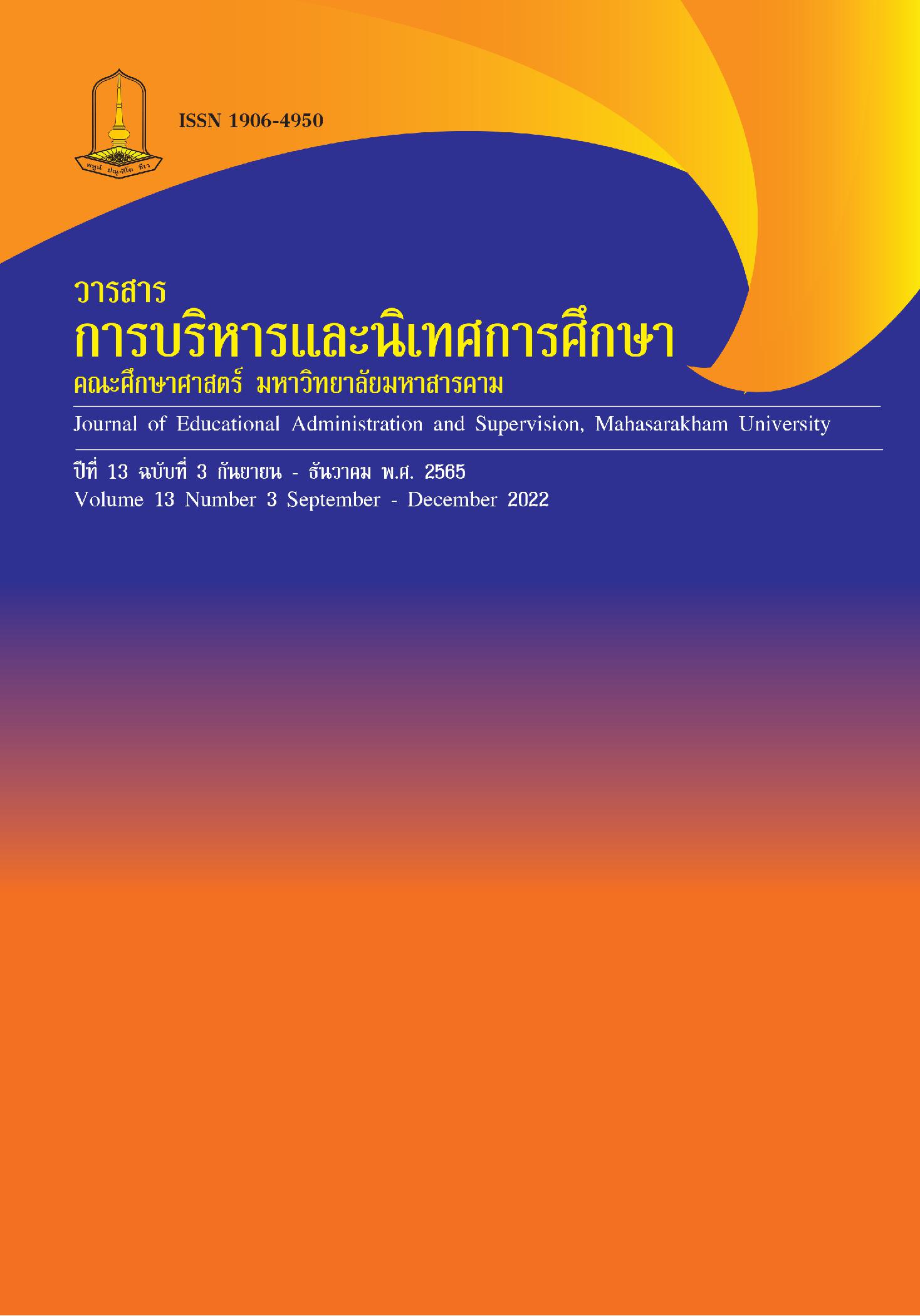A New Normal Model of School Management for Performance Excellence in the Changing Context of P.P.A.O. Bantaladnua (Wankroo 2502) School
Main Article Content
Abstract
This research aimed to create a new school management model for pertormance excellence in changing contexts. The methods of this study are divided into three stages, which are as follows: 1) Study the conceptual framework of a new normal model of school management for performance excellence in the changing context by analyzing relevant documents and research papers, analyzing the content summary of recommendations from interviews (i.e., five school administrators and experts), and analyzing the summary of opinions from workshops that included 90 members of the teachers, educational personnel, and school board. 2) Created a draft of a new normal model of school management for performance excellence in the changing context, evaluated the suitability, possibility, propriety, and utility of the model, and revised it based on suggestions from five experts. 3) Tried out the model at P.P.A.O. Bantaladnua (Wankroo 2502) School, recorded the quality results, and analyzed questionnaires of 85 members of teachers, educational personnel, the school board, and 295 members of parents with 7 aspects: (1) leadership;
(2) strategy; (3) students; (4) measurement, analysis, and knowledge management;
(5) workforces; (6) operations; and (7) results. The mean and standard deviation were analyzed.
The results showed that (1) The new normal model of school management for
performance excellence in the changing context of P.P.A.O. Bantaladnua (Wankroo 2502) school gained the suitability, possibility, propriety, and utility of the model at the highest level.
(2) The model is structured according to a systematic process (input-process-output). The process part consisted of the PDCA quality cycles and the SUNTREE, which consisted of the schools of learning and agility, unity, networking, technology, and innovation, results-based management, ethics and transparency, and excellence, respectively. (3) The results of the implementation of the model showed that the P.P.A.O. Bantaladnua (Wankru 2502) school has improved performance in many aspects, such as student achievement, results of student reading proficiency assessment (RT), results of students' learner quality assessment(NT), and learners' morality and ethics; students have desirable characteristics; the school was certified for the 4th round of external quality assurance with good evaluation results, etc.(4) The evaluation of the model's utilization by teachers, educational personnel, the school board, and parents was evaluated at the highest level. The school management model from this study might be modified or used as a guideline for other schools.
Downloads
Article Details
References
กองยกระดับคุณภาพการจัดการศึกษาระดับอุดมศึกษา สำนักงานปลัดกระทรวงการอุดมศึกษา วิทยาศาสตร์วิจัยและนวัตกรรม. (2564). เกณฑ์คุณภาพการศึกษาเพื่อการดำเนินการที่เป็นเลิศฉบับปี2563 - 2566. กรุงเทพมหานคร: อมรินทร์ พริ้นติ้งแอนด์พับลิชชิ่ง จำกัด (มหาชน).
โนรีณี เบ็ญจวงศ์, และ นิรุทธิ์ นันทมาศวังนรา. (2565), ผู้บริหารสถานศึกษาในยุคโควิด-19. วารสารรัชต์ภาคย์, 16(47), 1-13.
มะลิวัลย์ โยธารักษ์, และ อรุณเกียรติ จันทร์ส่งแสง. (2564). รูปแบบการบริหารจัดการสถานศึกษาเพื่อการพัฒนาอย่างยั่งยืนสำนักงานเขตพื้นที่การศึกษาประถมศึกษาสุราษฎร์ธานี เขต 3. วารสารมจร อุบลปริทรรศน์, 6(3), 705-717.
สมาพร ลี้ัยรัตน์, ธานี เกสทอง, และ นันทิยา น้อยจันทร์. (2560). รูปแบบการบริหารคุณภาพโรงเรียนมาตรฐานสากลระดับประถมศึกษา. สุทธิปริทัศน์, 31(100), 261-273.
สำนักงานกรรมการข้าราชการพลเรือน. (ม.ป.ป.). หลักธรรมาภิบาลของการบริหารกิจการบ้านเมืองที่ดี.เรียกใช้เมื่อ 8 สิงหาคม 2565 จาก สำนักงานกรรมการข้าราชการพลเรือน: https://www.ocsc.go.th/sites/default/files/attachment/article/7.1_hlakthrrmaaphibaalkhngkaar-brihaarkicchkaarbaanemuuengthiidii.pdf
สำนักงานคณะกรรมการพัฒนาการเศรษฐกิจและสังคมแห่งชาติ. (2559). แผนพัฒนาเศรษฐกิจและ สังคมแห่งชาติฉบับที่ 12 (พ.ศ. 2560 - 2564). กรุงเทพมหานคร: สำนักงานคณะกรรมการ พัฒนาการเศรษฐกิจและสังคมแห่งชาติ.
สำนักงานคณะกรรมการพัฒนาการเศรษฐกิจและสังคมแห่งชาติ. (2565). แผนพัฒนาเศรษฐกิจและ สังคมแห่งชาติฉบับที่ 13. กรุงเทพมหานคร: สำนักงานคณะกรรมการพัฒนาการเศรษฐกิจและสังคมแห่งชาติ.
สำนักงานรางวัลคุณภาพแห่งชาติ สถาบันเพิ่มผลผลิตแห่งชาติ กระทรวงอุตสาหกรรม. (2564). เกณฑ์รางวัลคุณภาพแห่งชาติ ปี 2565-2566 (TQA Criterial for Performance Excellence Framework 2565-2566) กรุงเทพมหานคร: โรงพิมพ์ตะวันออก จำกัด (มหาชน).
สำนักงานเลขาธิการสภาการศึกษา. (2560). แผนการศึกษาแห่งชาติ พ.ศ. 2560- 2579. กรุงเทพมหานคร:พริกหวานกราฟฟิค.
อภิชาต อรรคอำนวย. (2564). รูปแบบการบริหารสถานศึกษาขนาดเล็กสู่ความเป็นเลิศ ของโรงเรียนโนนไฮหนองอีกุ้มวิทยา สังกัดสำนักงานเขตพื้นที่การศึกษาประถมศึกษากาฬสินธุ์เขต 1.วารสารการบริหารและนิเทศการศึกษา มหาวิทยาลัยมหาสารคาม, 12(3), 43-54.
อร่าม วัฒนะ นันทิยา น้อยจันทร์ และสาธร ทรัพย์รวงทอง. (2562) รูปแบบการบริหารสถานศึกษาสู่ความเป็นเลิศของโรงเรียนสังกัดองค์การบริหารส่วนจังหวัด. วารสารมหาจุฬาวิชาการ, 7(1), 55-70.
อัจฉรา นิยมาภา. (2564). รูปแบบการบริหารสถานศึกษาวิถีใหม่สู่คุณภาพการศึกษาที่พึงประสงค์ในบริบทที่เปลี่ยนแปลง. วารสารศึกษาศาสตร์ มสธ., 14(2), 178-195.
Ah-Teck, J. C., & Starr, K. (2013). Principals' perceptions of "quality" in Mauritian schoolsusing the Baldrige framework. Journal of Educational Administration, 51(5),680-704.
Bawany, S. (2018). Leading in a Disruptive VUCA World. New York: Expert InsightsSeries by Business Express Press (BEP) Inc. LLC. Retrieved from https://www.businessexpertpress.com/wpcontent/uploads/2020/04/Developing-a-High-Performance-Organization-in-a-VUCA-World.pdf
Denning, S. (2018). The Age of Agile: How Smart Companies Are Transforming the WayWork Gets Done. Amacom.
Medinilla, Á. (2012). Agile management: Leadership in an agile environment. Heidelberg:Springer.


